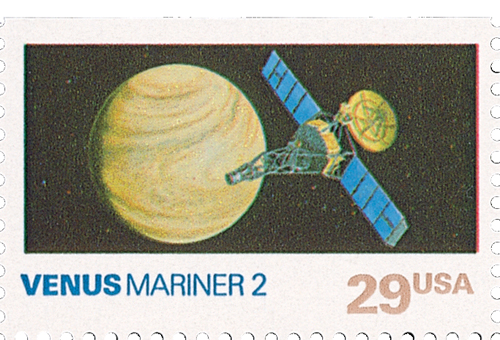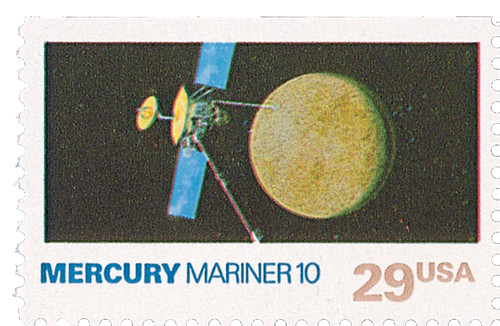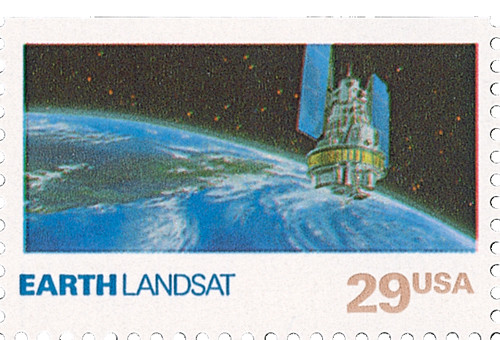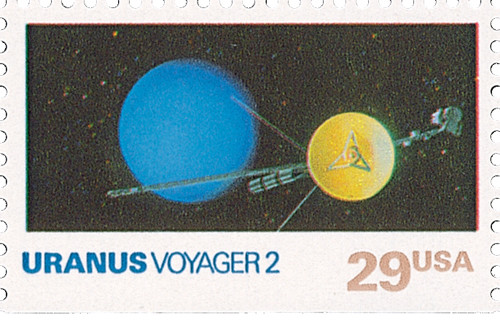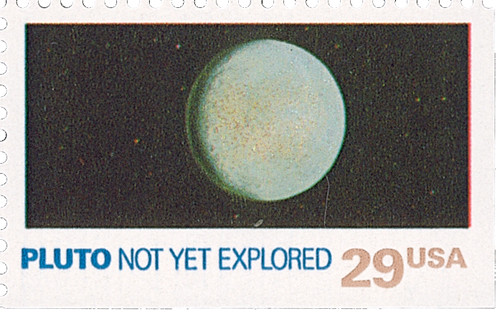
# 2569 - 1991 29c Space Exploration: Venus
US #2569
1991 Venus
- Part of set picturing nine planets and Earth’s moon
- Issued as part of Stamp Collecting Month
Category of Stamp: Commemorative
Set: Space Exploration
Value: 29¢
First Day of Issue: October 1, 1991
First Day City: Pasadena, California
Quantity Issued: 33,394,800
Printed by: Bureau of Engraving and Printing
Printing Method: Photogravure
Format: Booklets – 2 panes of 10 in each
Perforations: 11
Reason the stamp was issued: The set of Space Exploration stamps was issued in honor of the Voyager 2 space probe passing Neptune and the 11th annual Stamp Collecting Month.
About the stamp design: The Venus stamp pictures the planet and the Mariner 2 space probe. Launched in 1962, it was the first successful spacecraft in the program. In December, Mariner 2 became the first American spacecraft to encounter Venus.
These stamps were the first by Ron Miller, a former artist for the Smithsonian Institution’s National Air and Space Museum. He was asked to picture each of the Sun’s nine planets and the Earth’s moon with a spacecraft. This was to tie in the idea of America’s exploration of space. His original acrylic paintings were larger than those normally used for stamp art. This was to show all the details of the spacecraft.
Special design details: While most of the stamps name the spacecraft shown, the Pluto stamp has “not yet explored,” because no spacecraft had reached that planet at the time. (The space probe New Horizons explored Pluto in 2015.)
First Day City: The First Day of Issue ceremony took place at the Jet Propulsion Laboratory in Pasadena, California, on October 1, 1991, the start of Stamp Collecting Month.
Unusual thing about this stamp: The USPS partnered with Paramount Studios to promote the stamps. The studio was celebrating the 25th anniversary of the Star Trek movies and television series. The stamp designs were unveiled on the bridge of the Starship Enterprise, the space vehicle featured in the series. Flyers promoting the stamps were included in the packaging of Star Trek video cassettes.
About National Stamp Collecting Month stamps: October has been designated by the US Postal Service as National Stamp Collecting Month. The first celebration occurred in 1981 as a way to promote the hobby of collecting stamps. Each year, new stamps are issued in early October to stimulate additional interest, and many philatelic organizations hold special programs during the month. The theme for the 1991 celebration was “Journey to a New Frontier… Collect Stamps.”
History the Space Exploration stamps represent: Uncovering the mysteries of the universe has been a pursuit of scientists and dreamers for all time. With the invention of telescopes, astronomers discovered some of the wonders of space. With the space age, researchers began sending spacecraft outside of Earth’s orbit to gain further insight into the planets of our solar system. Manned missions were followed by unmanned missions with the capability of traveling to distant planets. These stamps show some of the spacecraft and the images of the planets they captured as they flew by. Discoveries continue to be made with the space probes that still travel through our solar system.
Identical to Mariner 1, which had launched a month earlier, Mariner 2 launched from Cape Canaveral, Florida on August 27, 1962. On its journey to Venus, Mariner 2 experienced some issues, but most were remotely correctable or were corrected by the probe itself.
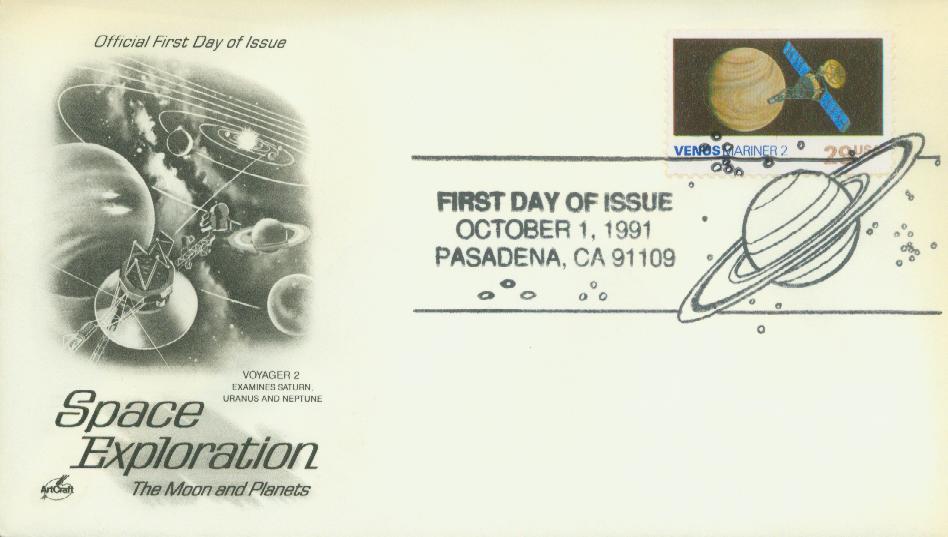
On December 14, Mariner 2 became the first spacecraft to encounter another planet. On that day, 110 days into its mission, it passed within 21,607 miles of Venus. One of the most notable pieces of data from this flyby was the temperature. The temperature of Venus’ atmosphere was measured to be 900 degrees Fahrenheit.

Mariner 2 continued to travel beyond Venus and sent back its last transmission on January 3, 1963. The entire mission had lasted 129 days. Though it no longer sends back data, Mariner 2 is still in orbit today.
A great deal of information about Venus was revealed through the Mariner 2 mission. A microwave radiometer measured temperatures on different spots of the planet, revealing that its temperature is generally the same all around. An infrared radiometer confirmed that radiation temperatures were the same as measurements made from Earth.
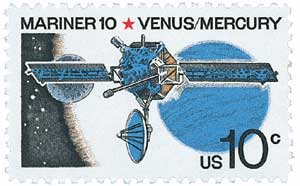
Data from the magnetometer revealed Venus has a persistent interplanetary magnetic field. Another test showed that Venus didn’t have a detectable magnetosphere or radiation belt. Mariner 2 provided more accurate measurements of Venus’ mass and astronomical unit. And findings suggested that Venus rotates much slower than Earth and in the opposite direction. Future missions would confirm this.
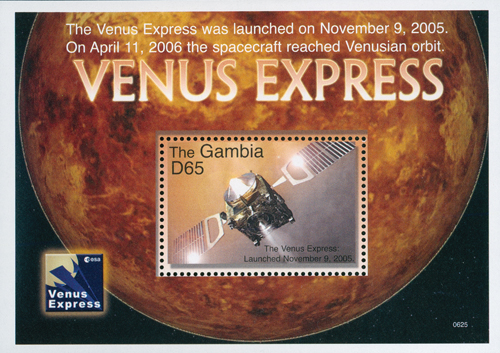
Additional data collected throughout the journey showed seven small solar bursts of radiation. The probe also discovered in the space between planets, solar winds move continuously.
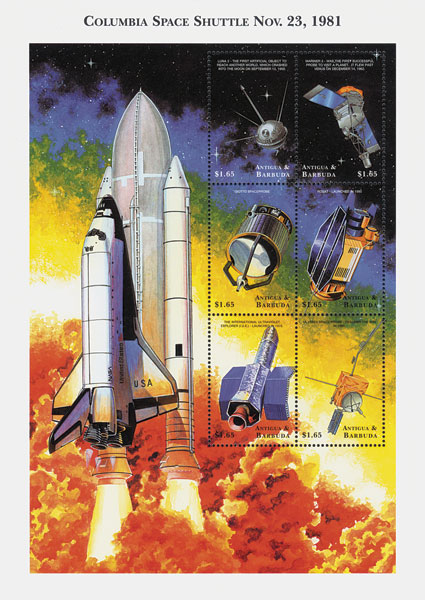
The next major mission to Venus occurred in 1970 when Venera 7 was the first to land a spacecraft on another planet. Finally, in the 1990s, the Magellan probe used radar to provide the first images of Venus’ surface. The photos revealed a planet covered with more than 1,000 volcanoes, some of which could still be active today.
Venus differs from Earth, and most of the planets, in that it rotates clockwise. Scientists speculate that Venus once spun in the same direction as Earth, but was struck by a large object, flipping the planet upside down, so it spins in the same direction but appears reversed.
Click here for more about Mariner 2.
US #2569
1991 Venus
- Part of set picturing nine planets and Earth’s moon
- Issued as part of Stamp Collecting Month
Category of Stamp: Commemorative
Set: Space Exploration
Value: 29¢
First Day of Issue: October 1, 1991
First Day City: Pasadena, California
Quantity Issued: 33,394,800
Printed by: Bureau of Engraving and Printing
Printing Method: Photogravure
Format: Booklets – 2 panes of 10 in each
Perforations: 11
Reason the stamp was issued: The set of Space Exploration stamps was issued in honor of the Voyager 2 space probe passing Neptune and the 11th annual Stamp Collecting Month.
About the stamp design: The Venus stamp pictures the planet and the Mariner 2 space probe. Launched in 1962, it was the first successful spacecraft in the program. In December, Mariner 2 became the first American spacecraft to encounter Venus.
These stamps were the first by Ron Miller, a former artist for the Smithsonian Institution’s National Air and Space Museum. He was asked to picture each of the Sun’s nine planets and the Earth’s moon with a spacecraft. This was to tie in the idea of America’s exploration of space. His original acrylic paintings were larger than those normally used for stamp art. This was to show all the details of the spacecraft.
Special design details: While most of the stamps name the spacecraft shown, the Pluto stamp has “not yet explored,” because no spacecraft had reached that planet at the time. (The space probe New Horizons explored Pluto in 2015.)
First Day City: The First Day of Issue ceremony took place at the Jet Propulsion Laboratory in Pasadena, California, on October 1, 1991, the start of Stamp Collecting Month.
Unusual thing about this stamp: The USPS partnered with Paramount Studios to promote the stamps. The studio was celebrating the 25th anniversary of the Star Trek movies and television series. The stamp designs were unveiled on the bridge of the Starship Enterprise, the space vehicle featured in the series. Flyers promoting the stamps were included in the packaging of Star Trek video cassettes.
About National Stamp Collecting Month stamps: October has been designated by the US Postal Service as National Stamp Collecting Month. The first celebration occurred in 1981 as a way to promote the hobby of collecting stamps. Each year, new stamps are issued in early October to stimulate additional interest, and many philatelic organizations hold special programs during the month. The theme for the 1991 celebration was “Journey to a New Frontier… Collect Stamps.”
History the Space Exploration stamps represent: Uncovering the mysteries of the universe has been a pursuit of scientists and dreamers for all time. With the invention of telescopes, astronomers discovered some of the wonders of space. With the space age, researchers began sending spacecraft outside of Earth’s orbit to gain further insight into the planets of our solar system. Manned missions were followed by unmanned missions with the capability of traveling to distant planets. These stamps show some of the spacecraft and the images of the planets they captured as they flew by. Discoveries continue to be made with the space probes that still travel through our solar system.
Identical to Mariner 1, which had launched a month earlier, Mariner 2 launched from Cape Canaveral, Florida on August 27, 1962. On its journey to Venus, Mariner 2 experienced some issues, but most were remotely correctable or were corrected by the probe itself.

On December 14, Mariner 2 became the first spacecraft to encounter another planet. On that day, 110 days into its mission, it passed within 21,607 miles of Venus. One of the most notable pieces of data from this flyby was the temperature. The temperature of Venus’ atmosphere was measured to be 900 degrees Fahrenheit.

Mariner 2 continued to travel beyond Venus and sent back its last transmission on January 3, 1963. The entire mission had lasted 129 days. Though it no longer sends back data, Mariner 2 is still in orbit today.
A great deal of information about Venus was revealed through the Mariner 2 mission. A microwave radiometer measured temperatures on different spots of the planet, revealing that its temperature is generally the same all around. An infrared radiometer confirmed that radiation temperatures were the same as measurements made from Earth.

Data from the magnetometer revealed Venus has a persistent interplanetary magnetic field. Another test showed that Venus didn’t have a detectable magnetosphere or radiation belt. Mariner 2 provided more accurate measurements of Venus’ mass and astronomical unit. And findings suggested that Venus rotates much slower than Earth and in the opposite direction. Future missions would confirm this.

Additional data collected throughout the journey showed seven small solar bursts of radiation. The probe also discovered in the space between planets, solar winds move continuously.

The next major mission to Venus occurred in 1970 when Venera 7 was the first to land a spacecraft on another planet. Finally, in the 1990s, the Magellan probe used radar to provide the first images of Venus’ surface. The photos revealed a planet covered with more than 1,000 volcanoes, some of which could still be active today.
Venus differs from Earth, and most of the planets, in that it rotates clockwise. Scientists speculate that Venus once spun in the same direction as Earth, but was struck by a large object, flipping the planet upside down, so it spins in the same direction but appears reversed.
Click here for more about Mariner 2.





